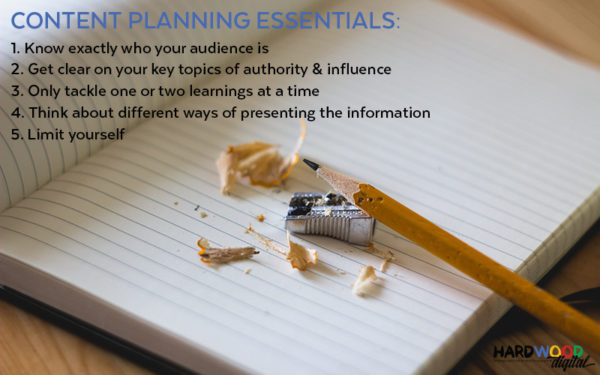Would you like to improve SEO and authority with your readers? Then thoughtful, well written website content is your secret weapon. The problem is executing a great content strategy can be hard.
Do you have a content planning process that works for you? Do you tend to fly by the seat of your pants and write about what ever happens to be on your mind that day?
The problem is that if you’re creating content in a haphazard, unfocused way your reader will find it harder to engage with you. To improve SEO and get reader engagement you need to take a targeted, systematic approach.
Writing relevant, useful content for your website is one of the best ways to improve SEO authority for your website.
If you are anything like me you really enjoy the writing process. What you don’t enjoy is deciding what to write about, when to write about it and how to present it. You know about content calendars and being organised. And, in your dreams that is the person you would love to be.
You jot down ideas galore but when it comes to putting fingers to keyboard you often draw a blank:
- Which thing should you write about first?
- How should you break it down?
- What’s a good title to use?
- Will it help improve SEO?
Before you know it your writing time is over and you’ve managed to:
- run your WordPress updates
- check Facebook three times
- write ANOTHER list of blog post ideas and
- play 14 games of Candy Crush.
In truth, we all have plenty of things to write about and, honestly, that’s the biggest part of the problem.
I call it the funnel effect, our brain is like the wide mouth of the funnel, brimming with knowledge and ideas that we want to get out.
Trouble is, when it comes to getting those ideas out they have to come out of a tiny hole at the bottom. Each idea fighting to come out before the other, creating a tangled mess that stops you from actually getting your words out and on to the screen.
Before you start content planning know who you are writing for.
You’ve probably heard this a thousand times. Know who that one person is that you are writing for and write what they want to hear.
Have you actually been through this exercise? Narrowed down who that one person is to the point that you can picture them? Once you understand exactly who you’re writing for it’s easier to plan out what you want to tell them. It’s also easier to present it in a style and format that suits them.
Big tip for you here…there’s a good chance that you know what your audience needs to know. However, what you think they NEED to know and what they WANT to hear can be two very different things.
I encourage you to watch and listen to your audience, really pay attention to the questions they ask and figure out what it is that they want to hear. Keyword research will help you to understand what terms people are actually looking for too.
If you’re looking to improve SEO on your site then including the exact terms people is especially useful.
Take what you know people NEED and turn it into the content that they WANT. This requires tweaking how you present it and the way in which you address different pain points. The better you get to know your one person, the easier it will become.
Know what your core subject matter is.
You have a wide breadth of knowledge on your subject matter. Often, this is the biggest sticking point when it comes to figuring out exactly what to write about.
Narrow down your area of expertise to two or three core topics.
- For a physio it might be PREVENTION and TREATMENT.
- A foodie might cover HOME COOKING and DINING OUT.
- An interior stylist might cover MICRO SCALE and MACRO SCALE whilst an interior designer might talk about RENOVATION, STYLING and DESIGN.
Knowing what these core topics are will not only help you decide what to write they’ll also help you improve SEO.
Each of these core topics can be broken down into a series of sub topics and then further into individual ideas. Mind maps are perfect to brain storm and break down these ideas. Leaving you with a list of ideas that can be spread out into a writing and development schedule.
Starting with the same two or three core topics will ensure that you are consistently building your authority and giving your readers what they are coming to you for. Generating a writing schedule will ensure that you know exactly what you need to focus on writing or creating each time you sit in front of your computer.
You don’t have to feel locked into a writing schedule. Unless you are working towards a launch or have sponsored content to deliver allow yourself some freedom to choose what you’ll write about. Having only one thing to choose from can be limiting if it’s REALLY not what you feel like writing about.
Click here to download my mind mapping template + other great content planning resources.
Only tackle one or two key points with each piece of content
Once we start it can be difficult to:
- Know where to stop
- Organise our thoughts into logical order
This is why it is really important to only tackle one or two key points at a time. Sure this post has five tips, but they are all related to content planning.
A benefit of working through the mind mapping process is that you’ll have drilled down to a single idea at the end of each tree branch. Now that you have your list it’s time to move on to the next part of your content planning.
In terms of optimisation tackling only one key point at a time will help you improve SEO. This is because search engines can easily identify what your blog post is about and index it accordingly.
Figure out how you want to present your content
Every idea you end up with is probably worthy of creating some long form content, a blog post for example. Don’t get bogged down with the idea that you need to go to these lengths all the time. We need content for social media too so be creative and, as you put your writing schedule together nominate a format to go with each idea.
Think video, interview, list post, infographic, podcast, step by step, case study, social media visual, storyboard, screencast…the list is endless.
It’s also important not to reinvent the wheel time after time. What long form content do you already have that can be broken down into smaller chunks or recreated visually? Likewise, what social media posts do you have that could be collected together to create a longer, more detailed piece of content?
Having an idea of how you want to present each idea will make it even easier once it comes to creating the content because not only do you have the title, you also have the format planned. Boredom averted!
PRO TIP: Don’t forget to add Alt Tags to your images, they’ll help you improve SEO on your posts.
Put a limit on yourself
Now that you have your content list it’s time to start writing and creating. With better direction around the why and how of each post you’ll find it much easier to sit down and get going. What’s important here is that you actually get some content completed!
If you’re writing an email to your list, grab your topic and limit yourself to 400 words. When you’re keeping in contact on a regular basis people don’t need more than that in their inbox.
You’ll be surprised how quickly you get your thoughts out and how good they are because you haven’t allowed yourself any space for waffle. Short and sweet and to the point.
Keep your social media posts short and sweet. Sometimes a simple one line question is enough but visual content is going to be king. When you are creating short form content aim to do it in batches.
Photographing flat lays or still life scenes? get a bunch knocked over in one go. Filming video? Have a few scripts and changes of clothes organised and knock off a few in one sitting.
Content for your website is where things are likely to get drawn out a bit. Don’t be afraid to impose a word limit on yourself here either but don’t feel that you have to.
If you need to do research, then get that done first, make notes and then go for it. Whatever works for you and your writing style. One way or another you’ll find it much easier because you’ve already narrowed down exactly what that one idea is that you are covering.
If you want to improve SEO on your website blog posts should be a minimum of 300 words.
Chances are some of you will like your digital tools for content planning but I am much more a pen and paper kind of girl. I have a couple of content planning sheets that I use for all my idea generation.
After I’ve got my ideas generated I create my writing calendar and from there comes my content calendar. I find that creating first and then scheduling it takes a lot of pressure off and enables me to tell a much more coherent ‘story’ because, just like you, I find the content planning part hard.
Click here to download my content planning tools.
What tools work best for you?





Awesome tips.Now to put them into practice!